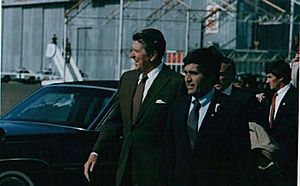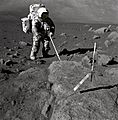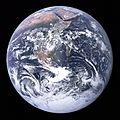Harrison Schmitt facts for kids
Quick facts for kids
Harrison Schmitt
|
|
|---|---|
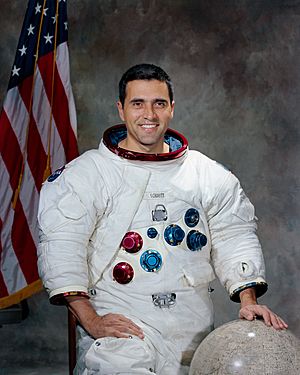
Schmitt in 1971
|
|
| United States Senator from New Mexico |
|
| In office January 3, 1977 – January 3, 1983 |
|
| Preceded by | Joseph Montoya |
| Succeeded by | Jeff Bingaman |
| Personal details | |
| Born |
Harrison Hagan Schmitt
July 3, 1935 Santa Rita, New Mexico, U.S. |
| Political party | Republican |
| Spouse | Teresa Fitzgibbon |
| Education | |
| Awards | NASA Distinguished Service Medal G. K. Gilbert Award (1989) |
| Space career | |
| NASA astronaut | |
|
Time in space
|
12d 13h 52m |
| Selection | NASA Group 4 (1965) |
|
Total EVAs
|
3 on the lunar surface |
|
Total EVA time
|
22h 3m |
| Missions | Apollo 17 |
|
Mission insignia
|
 |
| Retirement | August 30, 1975 |
| Scientific career | |
| Fields | Geology |
| Institutions | |
| Thesis | Petrology and Structure of the Eiksundsdal Eclogite Complex, Hareidland, Sunnmøre, Norway (1964) |
Harrison Hagan "Jack" Schmitt (born July 3, 1935) is an American geologist, a former NASA astronaut, a university professor, and a former U.S. senator for New Mexico. He is famous for being the most recent person still alive to have walked on the Moon. He is also the only person who walked on the Moon who was not a military pilot.
In December 1972, Schmitt was part of the Apollo 17 mission. He was the first scientist-astronaut from NASA Astronaut Group 4 to fly into space. Since Apollo 17 was the last Apollo mission, he became the twelfth person to step on the Moon. He was also the second-youngest person to do so. He was the second-to-last person to leave the Moon's surface. He got back into the Lunar Module just before commander Eugene Cernan. Schmitt is still the only professional scientist to have traveled beyond low Earth orbit and visited the Moon. Before his Apollo 17 training, he helped train other Apollo astronauts. He taught them about geology for their Moon missions.
Schmitt left NASA in August 1975. He decided to run for election to the United States Senate in New Mexico. He ran as a Republican candidate in 1976. He won against the Democratic senator, Joseph Montoya. In 1982, Schmitt lost his re-election bid to Democrat Jeff Bingaman.
Contents
About Harrison Schmitt
Early Life and School
Harrison Schmitt was born on July 3, 1935, in Santa Rita, New Mexico. He grew up in nearby Silver City. He finished Western High School in 1953. In 1957, he earned a Bachelor of Science degree in geology from the California Institute of Technology. He then studied geology for a year at the University of Oslo in Norway. He did this as a Fulbright Scholar. In 1964, he received his Doctor of Philosophy degree in geology from Harvard University. His studies were based on his work in Norway.
His Time at NASA
Before joining NASA in June 1965, Schmitt worked at the U.S. Geological Survey. He helped create ways for astronauts to study geology on the Moon. After he was chosen as an astronaut, Schmitt spent a year learning to fly jet planes. When he returned to the astronaut team in Houston, he helped train Apollo crews. He taught them how to observe geology from lunar orbit. He also taught them how to work as geologists on the Moon's surface. After each Moon landing, he helped examine the rocks brought back from the Moon. He also helped the crews write their scientific reports.
Schmitt learned a lot about the CSM and LM systems. In March 1970, he was the first scientist-astronaut chosen for a space flight. He joined Richard F. Gordon Jr. and Vance Brand on the backup crew for Apollo 15. This meant they were next in line to fly on Apollo 18. However, Apollo 18 and Apollo 19 were canceled in September 1970. Geologists who supported the Apollo program strongly wanted a professional geologist to land on the Moon. They asked NASA to put Schmitt on another flight. So, in August 1971, Schmitt was assigned to Apollo 17. He replaced Joe Engle as the Lunar Module Pilot. Schmitt landed on the Moon with commander Gene Cernan in December 1972.
Schmitt says he took the famous picture of Earth called The Blue Marble. This is one of the most widely shared photos ever. His Apollo 17 crewmates, Gene Cernan and Ronald Evans, also say they took it. NASA officially credits all three of them.
While on the Moon, Schmitt was the only geologist among the astronauts. He collected a rock sample called Troctolite 76535. This rock has been called "the most interesting sample returned from the Moon." It helps show that the Moon once had a magnetic field.
Schmitt returned to the Lunar Module before Cernan. This means he was the next-to-last person to walk on the Moon. Since Cernan passed away in 2017, Schmitt is the most recent person still alive who has walked on the Moon. After the Apollo 17 mission, Schmitt helped record the geology findings from Apollo. He also helped organize NASA's Energy Program Office.
On April 29, 2018, a device named the Schmitt Space Communicator SC-1x was carried on a Blue Origin New Shepard rocket. This project was partly funded by NASA. It launched the first commercial two-way data and Wi-Fi hotspot service in space. It also sent the first commercial Twitter message from space. The device weighed about three-pound (1.4 kg). It was developed by Solstar, a company Schmitt advised. It launched 66 miles (106 km) above Earth's surface. This was a test of the technology. The device is now in the Smithsonian National Air and Space Museum.
His Time as a Senator
On August 30, 1975, Schmitt left NASA. He wanted to run for election as a Republican to the United States Senate. He would represent New Mexico in the 1976 election. He campaigned for 14 months, focusing on the future. In the Republican primary election on June 1, 1976, Schmitt won against Eugene Peirce. In the main election, Schmitt ran against Joseph Montoya, who had been a senator for two terms. Schmitt won with 57% of the votes, while Montoya got 43%.
He served one term as a senator. He was the chairman of the Science, Technology, and Space Subcommittee. This was part of the United States Senate Committee on Commerce. He tried to get re-elected in 1982. He ran against state Attorney General Jeff Bingaman. Bingaman said Schmitt did not pay enough attention to local issues. Bingaman's campaign slogan asked, "What on Earth has he done for you lately?" This, along with a difficult economy, led to Schmitt's defeat. He lost with 46% of the votes, while Bingaman got 54%.
After Being a Senator
After his time in the Senate, Schmitt became a consultant. He advised businesses, and worked on geology, space, and public policy. He is also a professor at the University of Wisconsin–Madison. He has always supported using resources from the Moon. In 1997, he suggested the Interlune InterMars Initiative. One of its goals was to help private companies get and use Moon resources. He was especially interested in lunar helium-3 as a fuel for future nuclear fusion reactors.
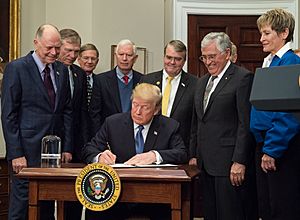
Schmitt was the chairman of the NASA Advisory Council. This group gives technical advice to the head of NASA. He held this position from November 2005 until he resigned on October 16, 2008. In November 2008, he left the Planetary Society. He disagreed with their policies. He felt they focused too much on Mars for human spaceflight. Schmitt believed going back to the Moon first would help get to Mars faster. He also had different views on climate change and international cooperation in space.
Schmitt also works as a senior research scientist at the Florida Institute for Human & Machine Cognition.
In January 2011, he was chosen to be the secretary of the New Mexico Energy, Minerals and Natural Resources Department. This was part of Governor Susana Martinez's team. However, he had to leave the job the next month. This was because he did not want to go through a required background check. The El Paso Times called him the "most celebrated" candidate for the job.
Schmitt wrote a book in 2006 called Return to the Moon: Exploration, Enterprise, and Energy in the Human Settlement of Space. He is also involved in community projects. One project is improving the Senator Harrison H. Schmitt Big Sky Hang Glider Park in Albuquerque, New Mexico.
Views on Climate Change
Harrison Schmitt has different ideas about climate change than many scientists. He believes that natural factors are the main cause of climate change, not human activities. He has also suggested that the risks of climate change are sometimes exaggerated.
Schmitt left the Planetary Society because he disagreed with their plans for space exploration. He thought that exploring the Moon was very important for future missions to Mars. He said, "The fastest way to get to Mars is by way of the Moon." He also had different views on environmental policies.
In 2013, Schmitt wrote an article for The Wall Street Journal with William Happer. They argued that more carbon dioxide in the air does not cause much global warming. They said that increasing carbon dioxide levels would actually help the planet by making crops grow better.
Awards and Honors
- NASA Distinguished Service Medal (1973)
- He was made an honorary member of the Geological Society of America in 1984. This was for his work in geoscience.
- He received the G. K. Gilbert Award in 1989.
- An elementary school in Schmitt's hometown of Silver City, New Mexico, was named after him in the mid-1970s. It is called Harrison Schmitt Elementary School.
- The AAPG's Special Award was changed to the Harrison Schmitt Award in 2011. This award recognizes people or groups who do not fit other honors. Schmitt received the award in 1973. This was for being the first geologist to land on the Moon and study its geology.
- He received the Leif Erikson Exploration Award in 2015. This was for his scientific work on the Moon in 1972. It was also for his help in training other astronauts in geology.
Schmitt was one of five people inducted into the International Space Hall of Fame in 1977. He was also one of 24 Apollo astronauts inducted into the U.S. Astronaut Hall of Fame in 1997.
Media
Schmitt is one of the astronauts in the 2007 documentary In the Shadow of the Moon. He also helped write the 2006 book NASA's Scientist-Astronauts by David Shayler and Colin Burgess.
Images for kids
-
Schmitt poses by the American flag, with Earth in the background, during Apollo 17's first EVA.
-
The Blue Marble, an iconic photograph of Earth, is credited to the three crewmen of Apollo 17
See also
 In Spanish: Harrison Schmitt para niños
In Spanish: Harrison Schmitt para niños


